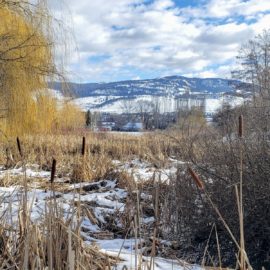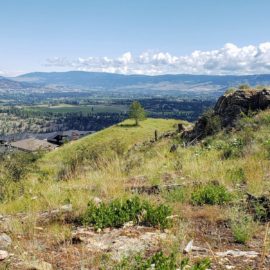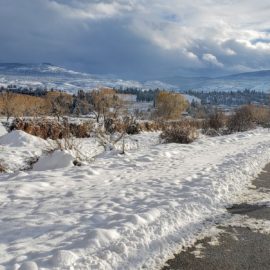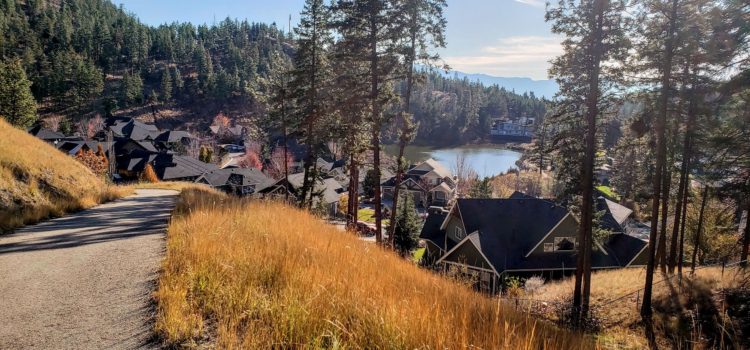
Kelowna Parks Challenge – Trip #14
This week I went on an adventure in the hills north of Kelowna as part of my Kelowna Parks Challenge. I hiked through part of Knox Mountain Park into the secluded subdivision of Magic Estates. I explored three parks I had never been to.
Read on for my impressions and reflections.
The Trip

Magic Estates is a residential neighbourhood that sits in a natural bowl up at the end of the canyon that divides the main peak of Knox Mountain from the Glenmore Highlands. As such it is a very scenic spot, surrounded by forested mountains, with a charming pond at its centre. The houses there were built between 1990 and 2005, which means it makes a great snapshot of what a desirable residential subdivision looked like in the 1990s. It is a ten-minute drive from downtown, but it feels like a much more remote location.
Caro Park

My adventure started just north of Sonora Park, which I explored last week. North of that park, the Old Glenmore subdivisions continue, with the houses getting newer as the hills get steeper.
Caro Park is a charming neighbourhood park, situated on a southeast-facing slope overlooking Dilworth Mountain and the Glenmore Valley. It is a good size, with room enough for a playground, a basketball court, two picnic tables and a number of pine trees.
Curiously, there is a triangular empty lot next to it that is zoned as parkland but has not been made part of the park. Nevertheless, a gap in the chainlink fence leads to an informal path through the area.
Washrooms and Drinking Fountains: There is no drinking fountain in this park. There is no washroom in this park.
Dog Rules: Because it is primarily a playground, dogs are not allowed in this park.
Knox Mountain Park – East
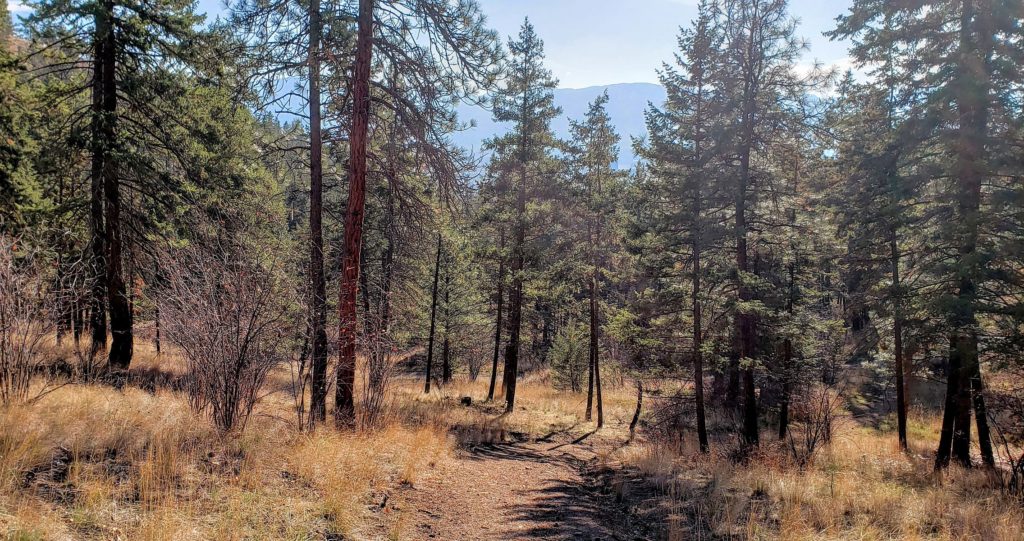
Knox Mountain Park is Kelowna’s largest park, so I never planned to tackle it all in one day. On two previous adventures, I visited peripheral sections of the park (Trip 3, Trip 5), but this was my first adventure through a large section of it.
The eastern section of Knox Mountain Park is separated from the main body of the park by Clifton Road and the residential lots that run along it. This eastern portion is not part of the original park area but was added ten to twenty years ago. Because of this, it is still mostly undeveloped. The Knox Mountain Management Plan of 2011 includes plans to sanction the main trails in this section, including the trails I used, and to install signage at the official entry points. It also mentions putting in a portable toilet at the southern entrance, but that has not been done yet.
This part of the park makes for a nice hike through mostly-undisturbed ponderosa pine and douglas fir forest. The trail from south to north through the middle of the parcel is uphill the entire way, only coming down for the last hundred metres or so when it descends into Magic Estates. It was fun, as always, to see the subtle differences in the forest at this elevation compared to the forests we explored at the Jean Road Trails and Mission Creek Regional Park.
Washrooms and Drinking Fountains: There is no drinking fountain in this part of the park. There is no washroom in this part of the park. There are two washrooms in the western part of the park.
Dog Rules: Dogs are only allowed on-leash and on trails in this part of the park. There is a dog off-leash area in the western part of the park.
Upper Canyon Open Space
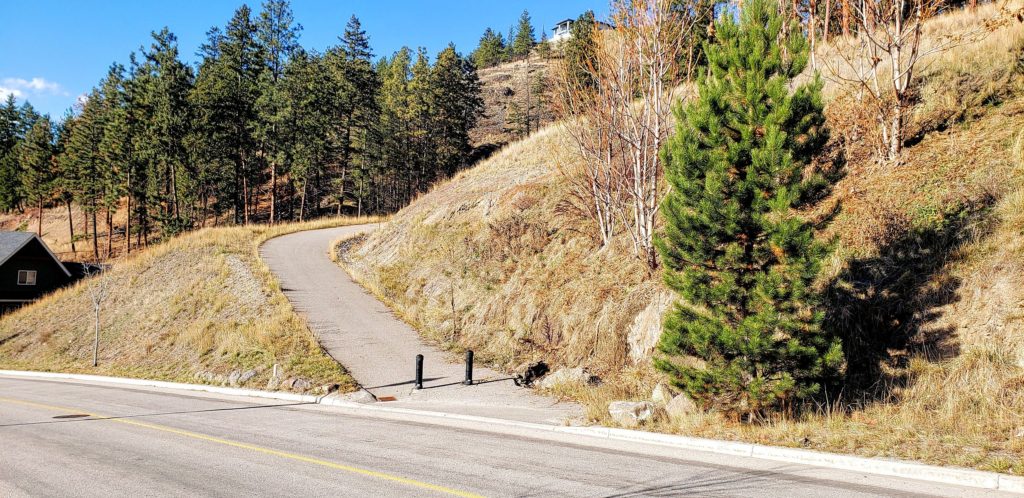
This mostly-undeveloped property hardly looks like a park but is part of an extensive network of similar terrain that winds around the Magic Estates and Wilden developments. For reasons I have yet to discover, this particular property was designated an official city park, while the rest of the connecting parkland has not been.
This park consists of steep slopes and a ravine, none of which have been made accessible with trails. The park’s only feature is a wide, asphalt walkway that leads into the park, then dead-ends. I did spot manhole covers as I walked it, so it might be that there is important sewer infrastructure here which rates the property a special designation.
Washrooms and Drinking Fountains: There is no drinking fountain in this park. There is no washroom in this park.
Dog Rules: Because it is a protected natural space, dogs are only allowed on-leash and on the trail in this park.
Blair Pond Park

This beautiful park lies at the heart of the Magic Estates development, if not the geographic centre. Once again, as with Redlich Pond, a natural feature has been tied into the storm sewer system to act as a stormwater retention facility. This, of course, is something it has been doing naturally for centuries.
On the east side, the pond connects with the natural slope of Knox Mountain Park East, while on the west side, space has been given to a playground, a tennis court, and a small parking lot. A trail leads through the park from south to north, providing views of the wetland habitat at the pond’s north end.
I really enjoyed the balance in this park between nature and development. A significant amount of natural vegetation has been left, especially as compared with some of the older parks I have visited.
Washrooms and Drinking Fountains: There is no drinking fountain in this park. There is a portable washroom in this park, on the south side of the parking lot.
Dog Rules: Dogs are only allowed on-leash and on the trail in this park.
Reflections
Park Design
Blair Pond Park provided a wonderful example of the growing environmental sensitivity in 1990s park design. When I compare it to the parks I saw last week in Old Glenmore, two differences, in particular, stand out.
When I visited Redlich Pond, I noticed that the surrounding residential lots came almost to the edge of the pond. Very little land around the water had been left for paths or animal habitat. Around Blair Pond, however, even though the lots come very close to the water in the northeast, more land has been left in a natural state around the pond.
Another difference has to do with the amount of land in Blair Pond that was left in a natural state. Unlike in Jack Robertson Memorial Park, where all of the native ecosystems had been stripped from the hills and replaced with lawn grass and standard European park trees, in Blair Pond Park the native forest has been left except where grass was specifically desired to border a path or a playground.
Leftover Green Space
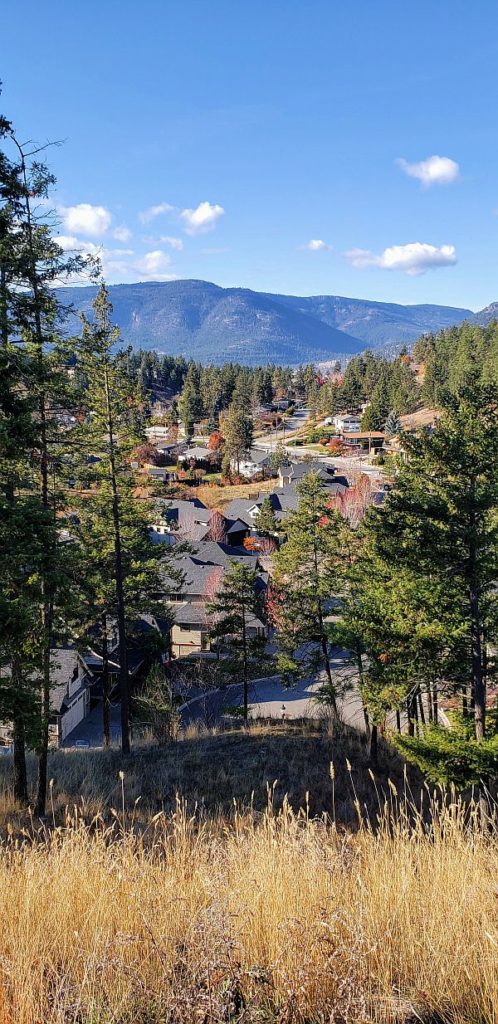
The Upper Canyon Open Space provided another example of a trend in subdivision design that may have begun in the 1980s or 1990s and continues to this day. Whereas in the middle of the twentieth century, all of the available land would be divided into perfect rectangular lots, in recent decades it has become more common to leave ravines, creeks, and steep slopes out and to designate them as green space.
I suspect this is a win-win for developers, since those sites were never well-suited for building houses on, and this practice is very environmentally-friendly in addition to increasing the attractiveness and value of the neighbourhood. Of course, since these sites are also not great for playing fields or playgrounds, they can’t meet all of a subdivision’s park needs; however, the local plants and animals don’t care about that, and these undisturbed areas make for great relict habitat and green corridors to maintain local biodiversity.
Conclusion
With the addition of the three complete parks I saw this week, I have now seen seventy of the two hundred and three parks on the Official List in one hundred and eight days. This means I have seen 34% of the parks in 30% of the year. Still on track for victory!
Please let me know what you thought about this or any of my adventures!

